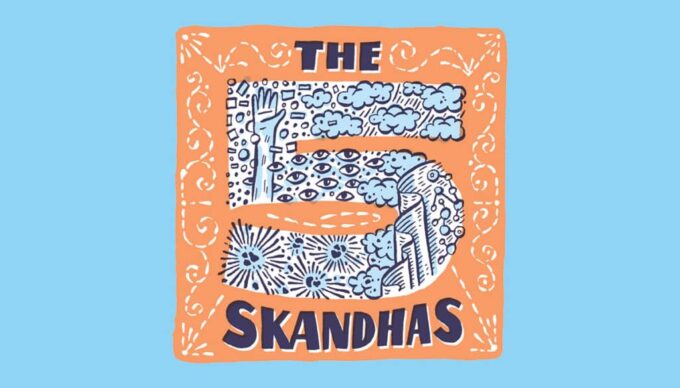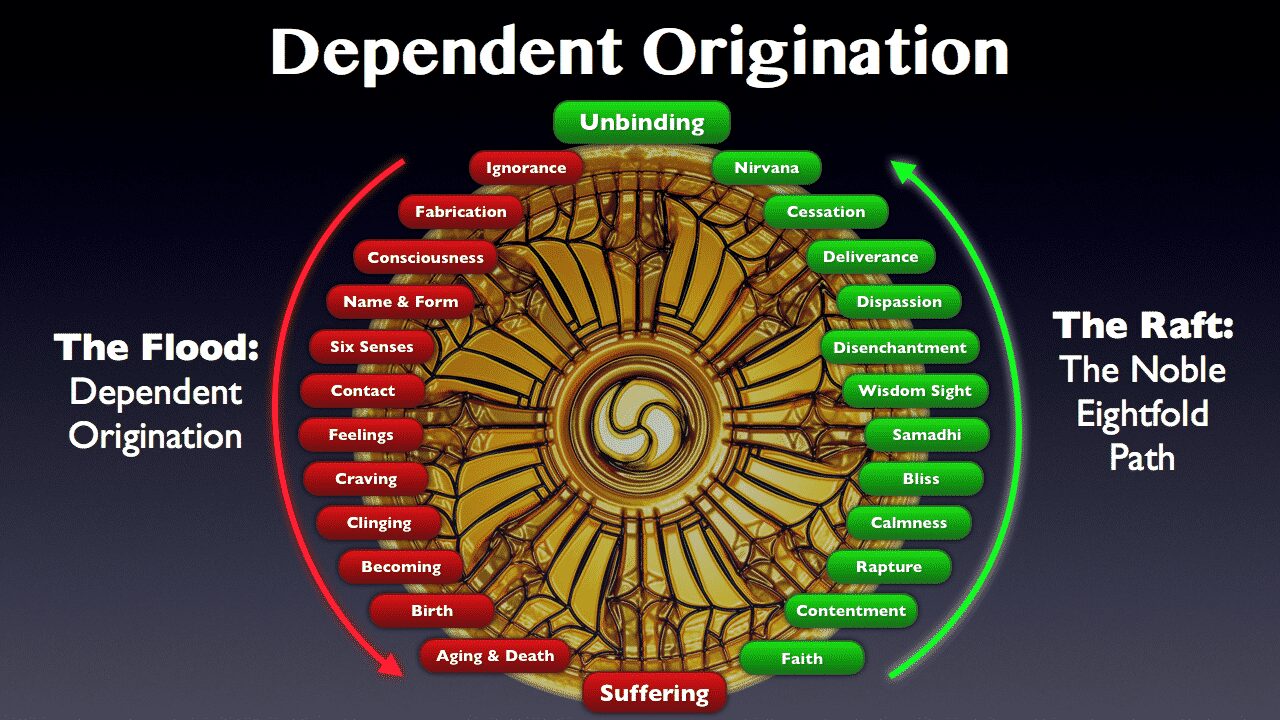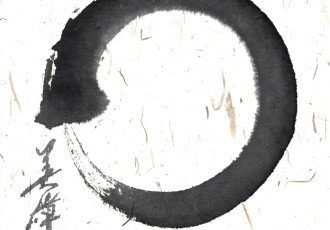Vairochana – Akshobhya – Ratnasambhava – Amitabha – Amogasiddhi
In Mahayana Buddhism, and particularly in Vajrayana (Tantric) Buddhism, the Five Dhyani Buddhas are a group of five “self-born” celestial buddhas who have always existed from the beginning of time. They are the transcendent Buddhas visualized in tantric meditation. The five Buddhas are Aksobhya, Amitabha, Amoghasiddhi, Ratnasaṃbhava and Vairocana. Each represents a different aspect of enlightened consciousness and they bring aid in spiritual transformation because they are great healers of the mind and soul.
The word Dhyani is derived from the Sanskrit dhyana, meaning “meditation.” The Dhyani Buddhas are also called Jinas (“Victors” or “Conquerors”). They are not historical figures, like Gautama Buddha, but transcendent beings who symbolize universal divine principles or forces. Many different forms of each deity exist, and different tantras can have slightly different explanations (for example, in the Kalachakra tantra, six Dhyani-Buddhas are mentioned, and most have different colors and shapes). Each displays different characteristics, mudras, each of them is associated with a different direction, rides a different animal, denotes a particular moment in the life of the historical Buddha, and has a different color.
The five Dhyani Buddhas represent the five basic types of human personality and demonstrate the absolutely perfected form of these personality types. Most importantly, each of them represents a negative quality as well as the completely transformed aspect of that failing, manifested as an enlightened wisdom.
Vairocana (also Vairochana or Mahavairocana) is a Buddha who is the embodiment of Dharmakaya (the ‘Truth-body’ or the ‘Embodiment of Truth’), and which therefore can be seen as the universal aspect of the historical Gautama Buddha. In Sino-Japanese Buddhism, Vairocana is also seen as the embodiment of the Buddhist concept of shunyata or Emptiness. Vairocana Buddha is a cosmic buddha and central figure in esoteric, or tantric, Buddhist practice. He represents the truth body, a non-physical, abstract body that is wisdom itself. The name Vairocana means “luminous” or “embodiment of light” in Sanskrit while in Japanese, Dainichi means “great sun.” He is often referred to as the “Life force that illuminates the universe,” the “great illuminating one,” and most importantly, the “all-encompassing Buddha.” Vairocana is believed to be everywhere and in everything; he is omniscient and omnipresent. All buddhas are thought to be emanations of him because he represents “transcendental” wisdom, the most clear and powerful form of wisdom. More specifically, he represents the conversion of ignorance into wisdom. In mandalas, he is often depicted sitting at the center while the other buddhas sit at the four cardinal directions. His wisdom is the wisdom of the essence of the dharma-realm meditation mudra.
Akshobhya The name Akshobhya means “Immovable” or “Unshakable.” Akshobhya’s Mirror-like Wisdom reflects all things calmly and uncritically, and reveals their true nature. Mirror-like Wisdom antidotes the poison of hatred and anger. In the mandalas, Akshobhya is usually positioned to the east, but he is sometimes placed in the center. He is believed to transform the human failing of anger into a clear mirror-like wisdom. With this wisdom, we see things just as they are, impartially and unaffectedly. The Buddha Akshobhya established the enlightened intention that all sentient beings could purify any degree of nonvirtue. Even the extreme nonvirtue of hatred, violence, and killing can be cleansed through relying on him as the focus of meditation, acknowledging and abandoning nonvirtuous actions, and invoking his blessings of purification. Akshobhya’s paradise is Abhirati, the Land of Exceeding Great Delight. Buddhists believe that whoever is reborn there cannot fall back to a lower level of consciousness.
Ratnasambhava means “the Jewel-born One” or “Origin of Jewels.” Ratnasambhava transmutes the poison of spiritual, intellectual and human pride into the Wisdom of Equality. Tibetan Buddhists teach that with the Wisdom of Equality one sees all things with divine impartiality and recognizes the divine equality of all beings. One sees all beings and the Buddha as having the same nature. Ratnasambhava is the Dhyani Buddha of the south. Ratnasambhava is sometimes shown holding his symbol, the ratna (jewel) or chintamani (wish-fulfilling jewel that grants all right desires). The chintamani is a symbol of the liberated mind. The ratna is often depicted in a threefold form as the triratna, signifying the union of Buddha, Dharma and Sangha. Ratnasambhava’s mudra is the varada mudra, the gesture of giving, or charity, which portrays him offering compassion and protection to his disciples. His wisdom is the wisdom of ecuality.
Amitabha means “Infinite Light.” Amitabha’s Discriminating Wisdom conquers the poison of the passions — all cravings, covetousness, greed and lust. With this wisdom, the disciple discerns all beings separately yet knows every being as an individual expression of the One. In the mandala of the Dhyani Buddhas, Amitabha is positioned to the west. He personifies the skandha of perception, thus, the eye and the faculty of seeing are associated with Amitabha, so, his throne-bearer is the peacock, with “eyes” on its plumes. The peacock symbolizes grace. Lotus Flower Amitabha’s symbol is the padma, or lotus. In Buddhism, the lotus can symbolize many things, including spiritual unfoldment, purity, the true nature of beings realized through enlightenment, and compassion, the purified form of passion. Devotees aspire to be reborn in Amitabha’s Western Paradise, known as Sukhavati, where conditions are ideal for attaining enlightenment. His wisdom is the wisdom of observation.
Amoghasiddhi means “Almighty Conqueror” or “He Who Unerringly Achieves His Goal.” Amogasiddhi’s All-Accomplishing Wisdom, or Wisdom of Perfected Action, antidotes the poison of envy and jealousy. This wisdom confers perseverance, infallible judgment and unerring action. Amoghasiddhi represents the practical realization of the wisdom of the other Dhyani Buddhas. He is described as the Dhyani Buddha of the realization of the Bodhisattva Path. A Bodhisattva is one who has forgone the bliss of nirvana with a vow to first liberate all beings. Amoghasiddhi is the Dhyani Buddha of the north. He embodies the skandha of volition, also called the skandha of mental phenomena or tendencies of mind. His symbol is the vishvavajra, or double vajra. It is made of two crossed vajras and symbolizes the highest comprehension of truth and the spiritual power of a Buddha. The throne of Amoghasiddhi is supported by garudas. A garuda is a mythical figure, half man and half bird. Amoghasiddhi’s mudra is the abhaya mudra, the gesture of fearlessness and protection. His wisdom is the wisdom of perfect practice.
Vairochana: Name meaning: Illuminating. Consort: White Tara. Bodhisattva: Samantabhadra. Wheel-turning Buddhas: Krakucchanda, Colour: white. Direction: Center. Mudra: Dharmachakra Turning the Dharma-wheel (teaching). Element: space. Five Senses: sight. Sense: energy channels. Organ: Heart. Delusion: ignorance, delusion. Enlightened Mind: All-encompassing Dharmadatu Wisdom. Family symbol and family: Wheel – Tathagata. Syllable: OM. Vehicle: Dragon. Aggregate: form (Skt. rupa). Season: No. Pure land: Central pure land Akanistha Ghanavyuha.
Akshobhya: Name meaning: Unshakable. Consort: Locana. Bodhisattva: Vajrapani. Wheel-turning Buddhas: Kanakamuni. Colour: blue. Direction: East. Mudra: Bhumisparsa Earth-touching. Element: water. Five Senses: sound. Sense: blood flow. Organ: Kidneys. Delusion: anger, hatred. Enlightened Mind: Mirror-like Wisdom. Family symbol and family: vajra – Vajra. Syllable: HUM. Vehicle: Elephant. Aggregate: consciousness (Skt. vijnana). Season: Winter. Pure land: eastern pure land Abhirati.
Ratnasambhava: Name meaning: Jewel-born. Consort: Mamaki. Bodhisattva: Ratnapani. Wheel-turning Buddhas: Kashyapa, Colour: yellow. Direction: South. Mudra: Varada Bestowing, giving. Element: earth. Five Senses: smell. Sense: flesh. Organ: Spleen. Delusion: pride, miserliness. Enlightened Mind: Wisdom of Equality. Family symbol and family: Jewel – ratna. Syllable: TRAM. Vehicle: Horse or lion. Aggregate: Sensation (Skt. vendana). Season: Spring. Pure land: southern pure land Shrimat.
Amitabha: Name meaning: Infinite Light. Consort: Pandara. Bodhisattva: Avalokiteshvara. Wheel-turning Buddhas: Shakyamuni. Colour: red. Direction: West. Mudra: Dhyana Meditation. Element: fire. Five Senses: taste. Sense: body heat. Organ: Liver. Delusion: desire, lust. Enlightened Mind: Discriminating Wisdom. Family symbol and family: Lotus – padma. Syllable: HRIH. Vehicle: Peacock. Aggregate: Perception (Skt. sanjna). Season: Summer. Pure land: western pure land Sukhavati.
Amogasiddhi: Name meaning: Conqueror. Consort: Green Tara. Bodhisattva: Vishvapani. Wheel-turning Buddhas: Maitreya. Colour: green. Direction: North. Mudra: Abhaya Fearlessness. Element: air. Five Senses: touch. Sense: inner winds. Organ: Lungs. Delusion: jealousy, fear. Enlightened Mind: All-accomplishing Wisdom. Family symbol and family: Double vajra – Karma. Syllable: AH. Vehicle: Garuda. Aggregate: Impulses (Skt. Samskara). Season: Autumn. Pure land: northern pure land Prakutauta.
photo credit: 5 dhyani




